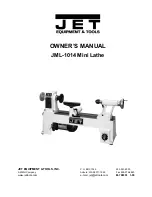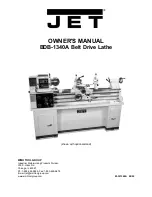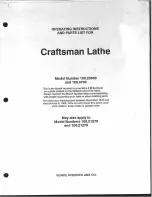
Model g0554z (Mfg 01/09+)
-31-
To mount a workpiece onto the spindle dead
center:
1. disConnECt lAthE FroM poWEr!
2. thoroughly clean and dry the tapered mating
surfaces of the spindle bore, tapered sleeve,
and the hss Mt#3 dead center.
3. to protect these mating surfaces from rust
and corrosion that could make removing them
difficult, apply a thin coat of light machine oil
to these surfaces, then use a c lean shop rag
to wipe the surfaces again. this will leave
a minimal amount of oil on the mating sur-
faces.
Note:
After applying the oil and wiping the
surfaces, do not touch the mating surfaces
with your hands or other objects, which could
deposit moisture or debris.
4. insert the center into the sleeve and the
sleeve into the spindle bore through the
chuck or faceplate.
5. install a lathe dog on the workpiece, then
mount the workpiece between the spindle
and tailstock centers with the tail of the lathe
dog inserted into the chuck or faceplate (see
Figure 36 for an example).
6. to remove the sleeve and center from the
spindle, insert a piece of round bar stock
or similar tool through the outboard end (on
the left side of the headstock), then tap the
sleeve loose.
Note:
Hold onto the sleeve and center as
you tap them loose to avoid dropping them
and damaging the tip of the center or the
bedways.
NOTICE
To avoid premature wear of the dead center
or damage to the workpiece, always use
lower spindle speeds and keep the tip of the
dead center mounted in the tail stock well
lubricated with an anti-sieze compound.
Figure 37. Example of using a dead center
installed in the tailstock.
dead Center
using a center in the Tailstock
When mounting long, slender workpieces that
extend more than 2
1
⁄
2
times its diameter beyond
the chuck jaws, use a center mounted in the
tailstock to support it (see
Figure 37 for an
example).
To mount a workpiece onto the tailstock dead
center:
1. disConnECt lAthE FroM poWEr!
2. thoroughly clean and dry the tapered mating
surfaces of the tailstock quill bore and the
carbide-tipped dead center.
3. to protect these mating surfaces from rust
and corrosion that could make removing them
difficult, apply a thin coat of light machine oil
to these surfaces, then use a clean shop rag
to wipe the surfaces again. this will leave
a minimal amount of oil on the mating sur-
faces.
Note:
After applying the oil and wiping the
surfaces, do not touch the mating surfaces
with your hands or other objects, which could
deposit moisture or debris.
4. use the tailstock handwheel to feed the
quill out from the casting at least 1", but for
purposes of stability and accuracy no more
than 2".
















































